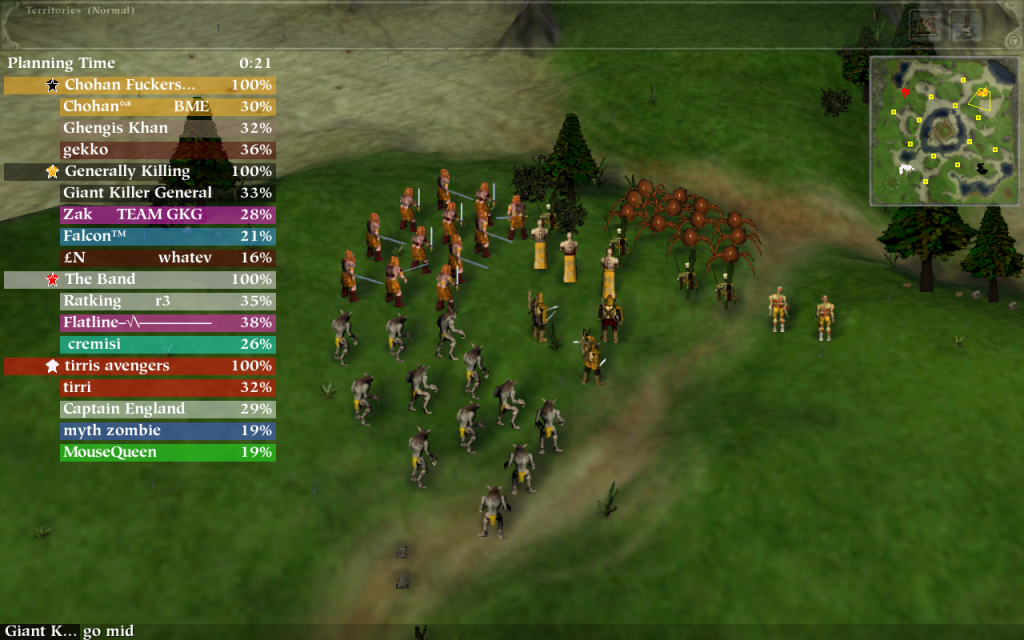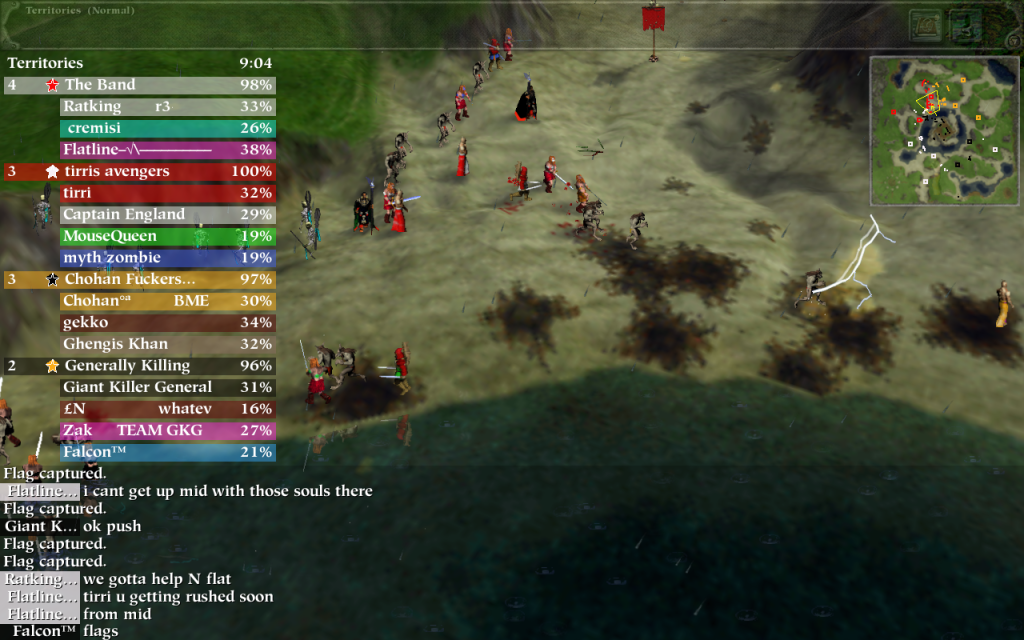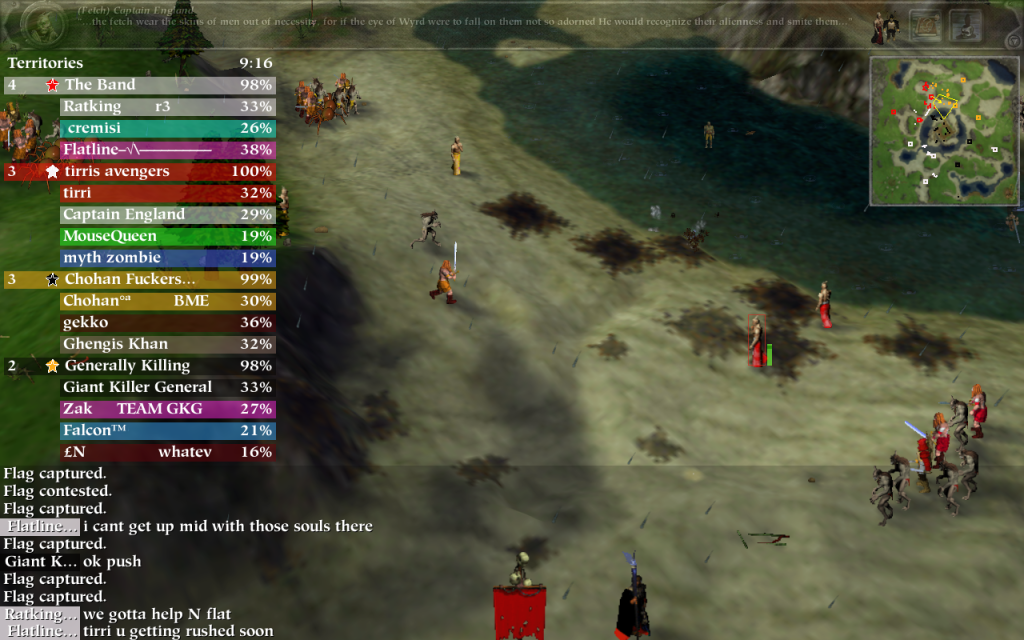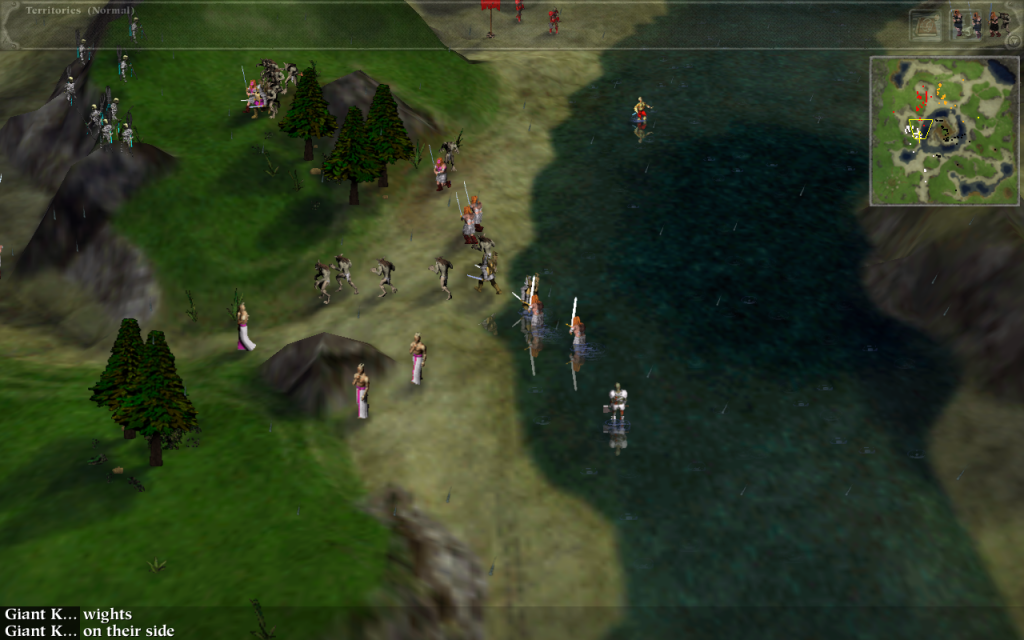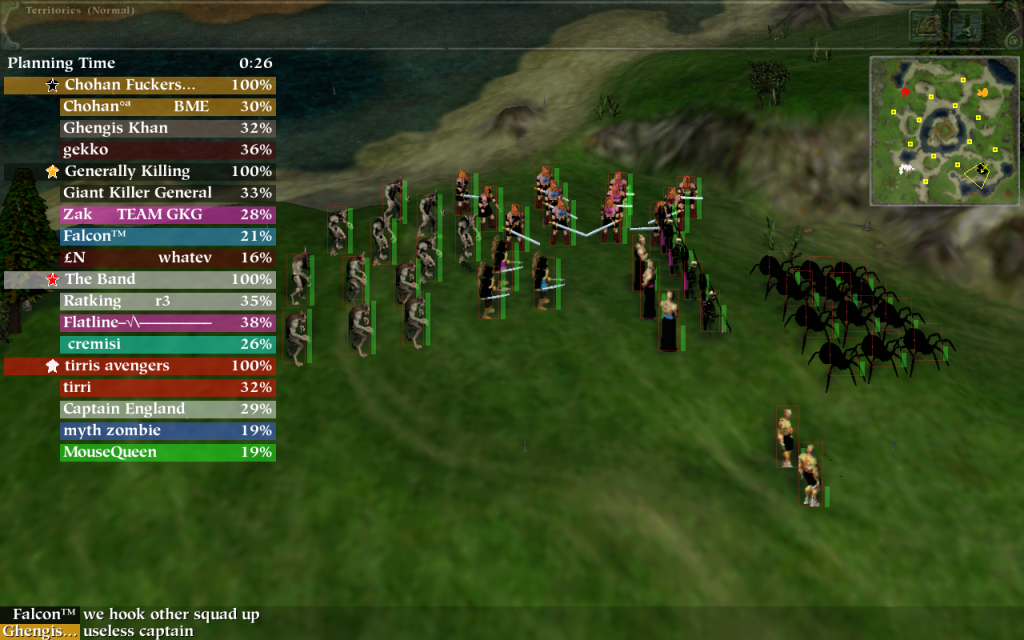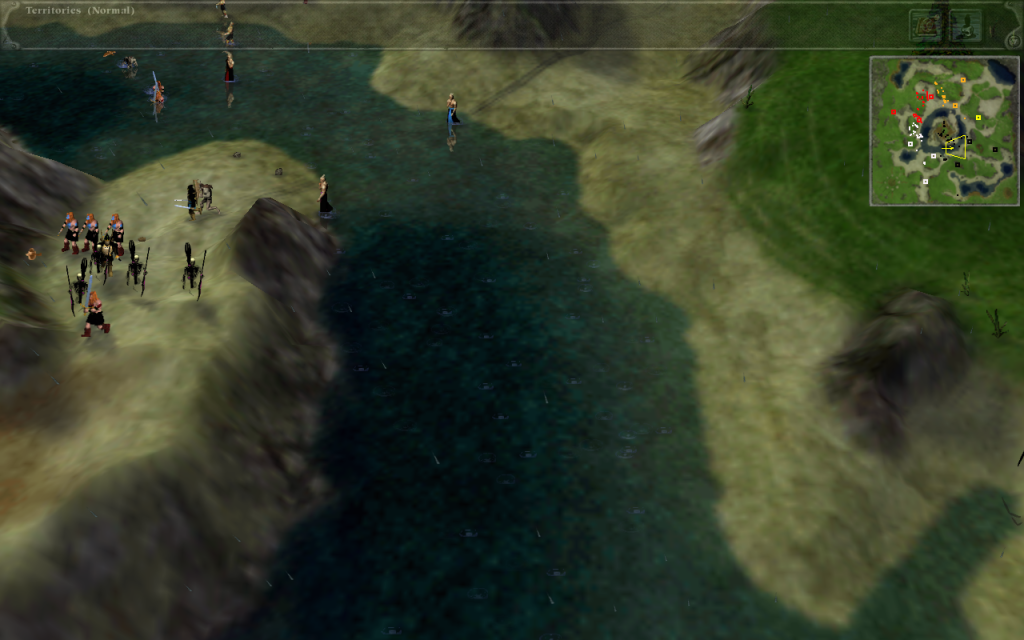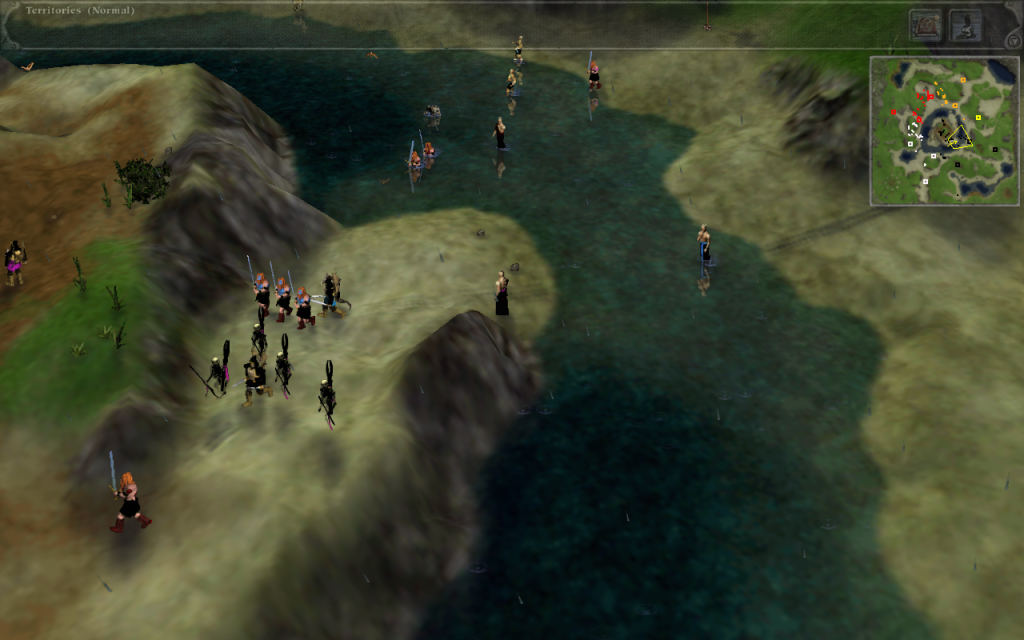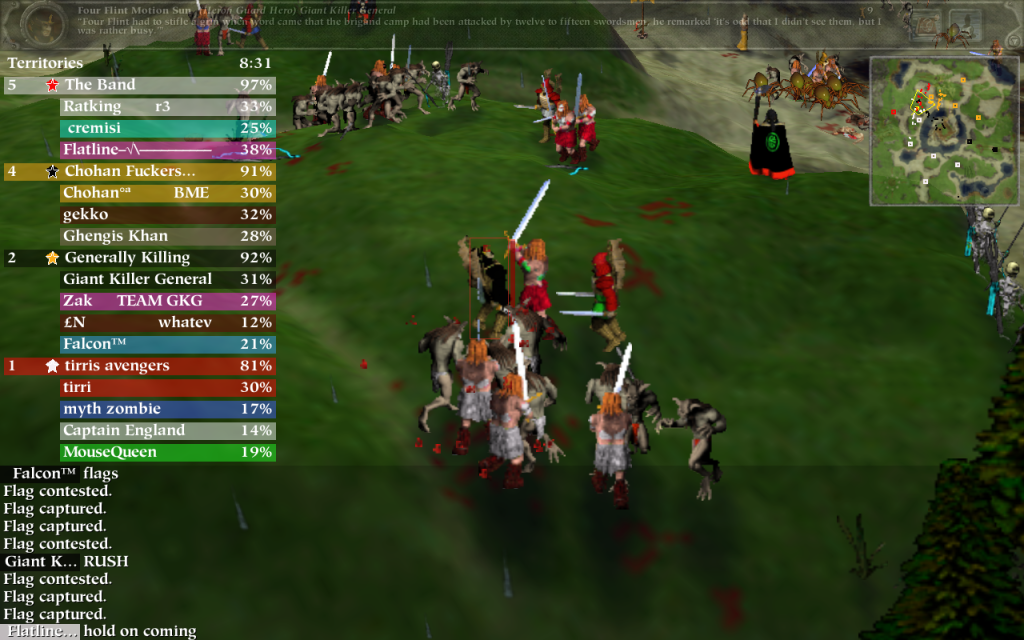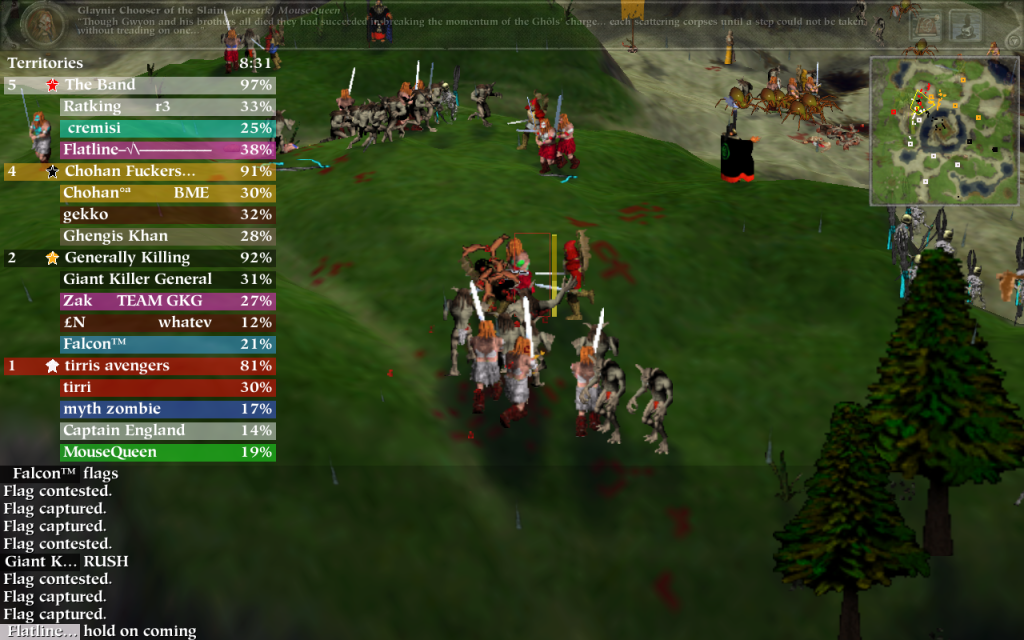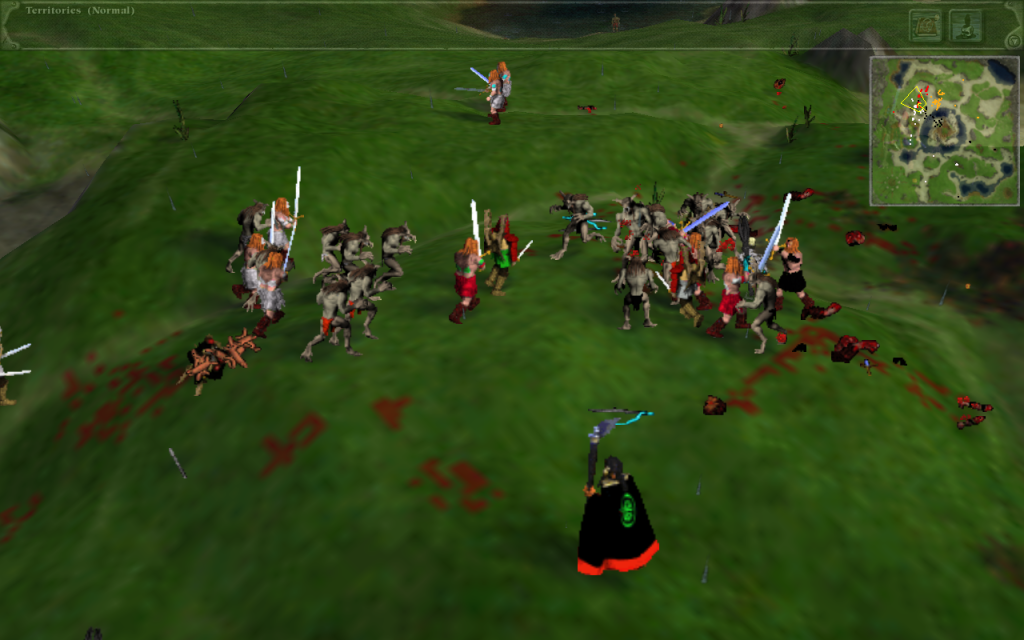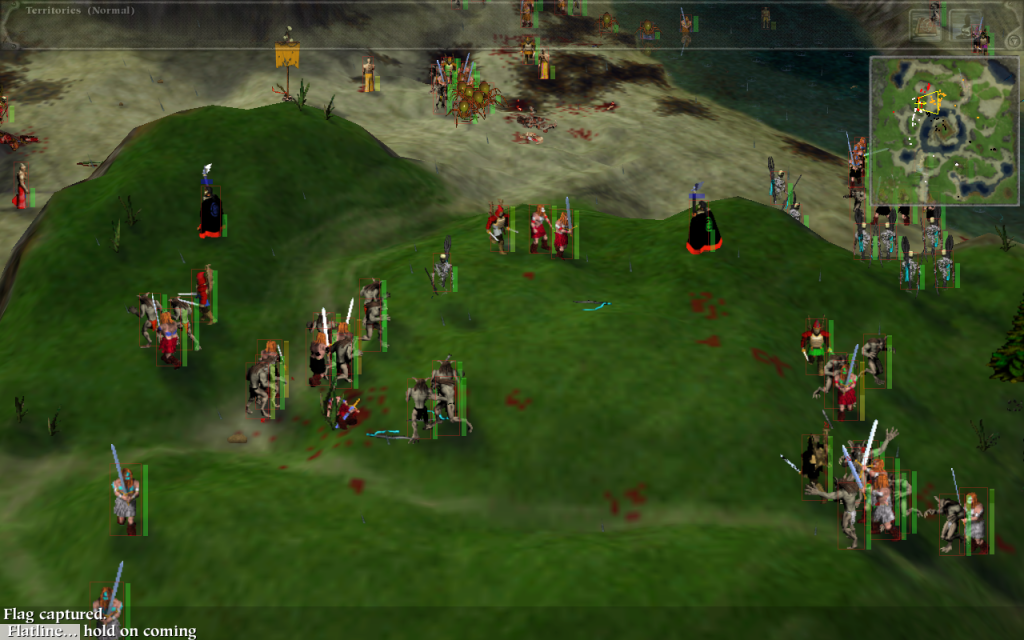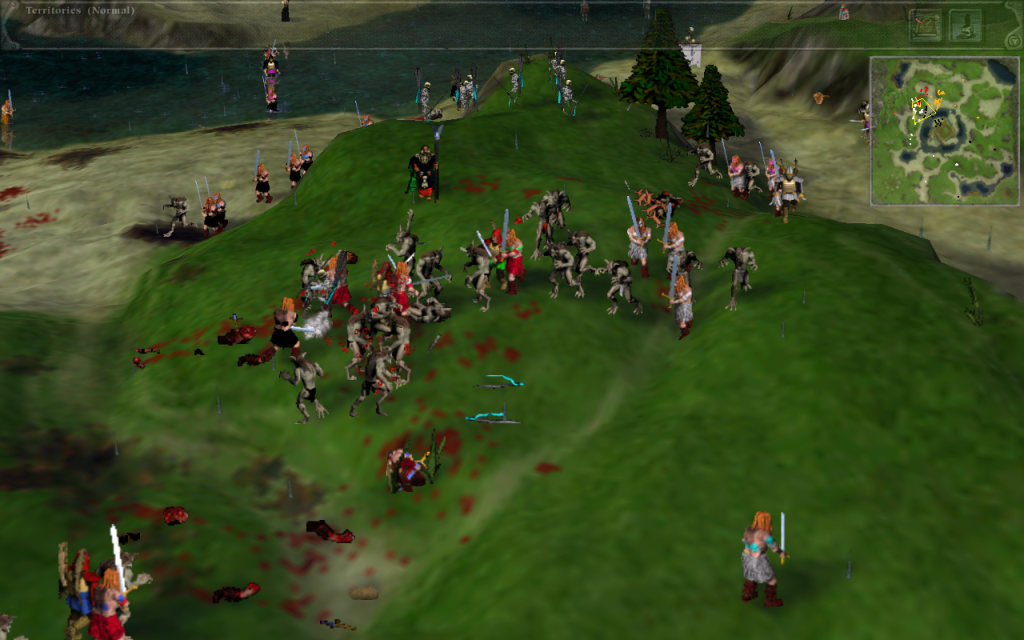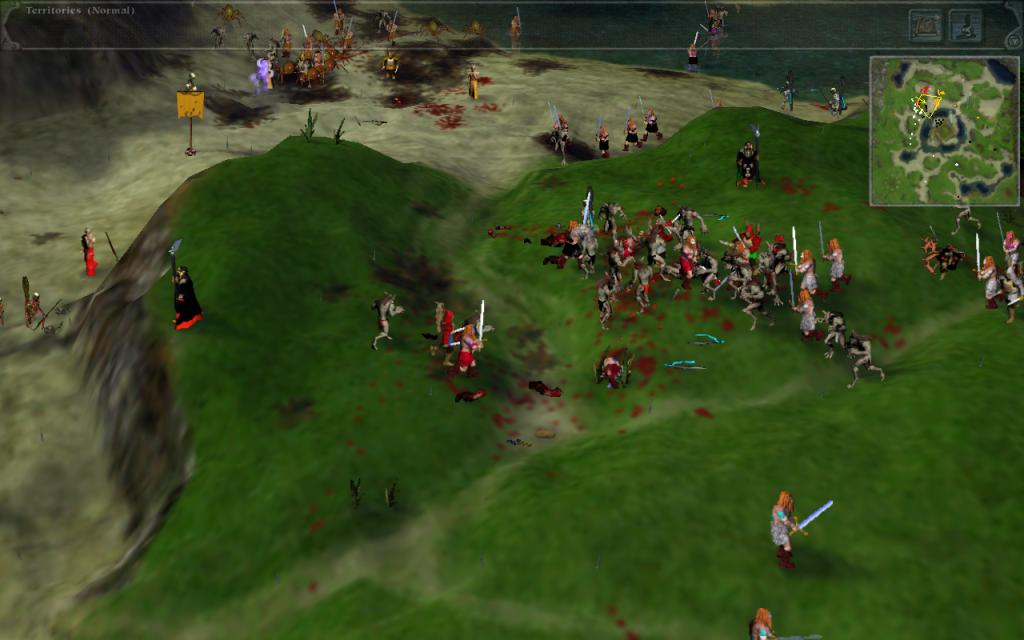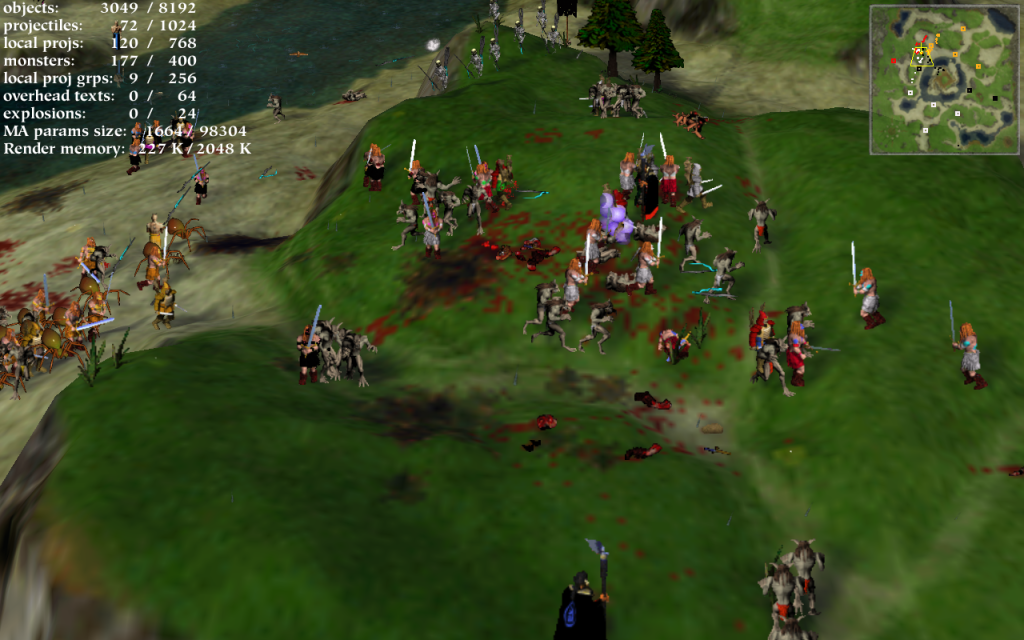Post by switch on Sept 12, 2012 20:49:05 GMT 2
After reading a great number of myth guides and playing myth for well over a decade; and being inspired by the shout-casts people have contributed, I've recently started to compile this guide which I think might be useful for everybody wondering how to get better at myth at the tactical level.
Please feel free to contribute or critique. This is a work in progress.
I'm also compiling a "players" guide and a "strategy" guide to go along with this "tactics" guide.
Myth study guide to win competitive myth games (guide): units & tactics
Advanced tactics
+ Frumius: "wight blast" manoeuvre used on "STB" or ball based games involving exploding a sunken wight in the last seconds of the game to throw the ball onto friendly positions.
+ Zer trow: manoeuvre involving moving trow slightly during attacks with other trow to buy microseconds of attack advantage.
+ adrenaline manoeuvre: see general, see carpet bombing.
+ RZA manoeuvre: see ww2
+ land wights: see wights
+ Fetch-bottle: see TFL gameplay.
+ see Traitor
+ see dummying
Ambient life: Deer, birds, peasants, spiders, wolves, pigs, and even wights (which can be healed) and such can be present on maps as ambient life. These are Green or Blue when capslock is active. Ambient life can be targeted using Shift Alt or Shift cntrl click I think.
Assassin: game type involving killing multiple mobile or static assassin units. Players are ranked based on timing and number of assassin kills (killing first scores higher if tie)
See arcane units:
See wolves
See peasents
Arcane units
Grub Wights: slightly modified wights with less health and some other changes.
General: Unit capable of generating force-field with mana. Useful for throwing dwarf bottles and satchels, or for blocking attacks. Otherwise is mediocre melee unit.
Dwarf Heroes: Mortar hero: unit with enormous range firing mortars that don't dud.
Archer hero: fires accurate arrows with minimal reload time. Deadly in groups larger than two or three against even the most powerful units
Warlock hero: Fires multiple fireballs
Advanced thrall: slightly stronger thrall that are slightly quicker than average.
Myrk giant: T click for skull attack, throws multiple explosive skulls based on mana. Melee attack "bloodlust" is notoriously random.
Forest Giants: occasional power unit - melee attack incredibly powerful, can walk on impassable terrain, becomes stoned at low health %
Extremely vulnerable to pus and small pus.
Spider queens: absurdly fast, attack causes paralysis.
Warriors of thell: faster than warriors, t-click to make immune to arrow attacks.
Wolves: assassin unit with minimal attack. Can cause significant damage in large packs
Peasants: assassin units that are defenceless and slow moving.
Archers: also known as "stick-shooters" cause minor damage and are inaccurate until vetted.
Longest range unit in game, notably longer range with elevation advantage.
High point cost and slow moving.
Fire arrows: useful against grass terrain types and unexploded ordinance. can only burn one area once.
Can stab at close range: double click against enemy units at close range to melee with dagger.
See ww2
See veterans.
Battle awareness: general in-game awareness concerning team trades, player positioning, unit positioning, resources, offensive and defensive options, etc. Generally left to team captains or veteran players.
Berzerks: fast attack melee units with powerful attack and large potential for vets.
Very useful in mixed units packs (i.e., herons + Myrks) and relatively cheap value (3 points)
Capslock: when depressed, displays all health bars for all team units.
Captains: Players responsible for unit trading as well as metagame command. Capable of distributing and redistributing units throughout game. Can control other players units.
Care Factor: Myth morale. See morale.
Caterpillar Phalanx: much criticized rabican strategy involving centers of gravity, masses of movement, etc.
see playder guide, see strat guide.
cbi: series of absurd cooperative maps based on original myth 2 levels + Zaknafien plugins offensively named. Also TWS & MWC team, see players guide.
Carpet bombing: TFL manoeuvre involving fetch and dwarf bottle attacks at range. See also TFL, Adrenaline manoeuvre
Cavalry: There are no horses in myth, however, certain plugins and third party maps allow for mounted units. The concept of the cavalry force should be considered, in regular myth play, as a metaphor for a mobile fast moving independent group, such as a trow or ghol, myrk or berserk pack.
Chat: in game chat feature. Can be "whispered" to teammates or "shouted" to entire game. Often used to distract players or warn players or both. Shift + up arrow persistently displays chat.
Coop: cooperative play. From default or third-party maps. Can be useful for practice or time-wasting.
see cbi
see mazz
Clumping: failure to micromanage larger numbers of units resulting in units being dangerously close together and therefore vulnerable to area of effect attacks.
Default unit standing:
Position units take when they arrive at their waypoints. In this position, the units will attack automatically opposing units that move within a certain distance.
Double click: when on friendly units, selects all units of that type.
When on enemy units, attacks enemy units of that type. When at close range, melees with some units; see archers, see ww2
Dummying: one player playing as or pretending to be another player that s/he is not.
Two or more players playing as the same player
Entire teams of players pretending to be different or anonymous players
Dwarfs: drop satchels, dud bottles in water, snow, rain. See fetch and ghols
Dwarf heroes: throw bottles farther, zero dud rate, more satchel capacity, drops bottle at death to set off satchels.
Dwarf mortar: long-range unit with high dud rate. Powerful area of effect attack if successful.
Dwarf mortar suicide: firing dwarf mortar at point-blank range with cntrl-click to cause last-ditch damage to attacking melee. See suicide.
Elevation: The height or depth of positions on myth maps. Units occupying a position with an elevation advantage receive significant benefits in terms of ranged and artillery attack.
See archers, warlocks, dwarfs.
F7: displays team percentages. Shift+F7 displays percentages persistently .
Fear: application for modifying parameters in myth.
Fear (psychological): terror instilled by imminent myth danger or expectation of craft play.
Fetch: magic attack disrupts dwarf bottles, pus, heron healing, warlock fire balls, spider packs, gholpacks
Attacks 'skip' on water extending range but with reduced damage.
In TFL can launch dwarf bottles over great distances, see advanced moves.
Flags: Objectives in myth. can be neutral, captured or contested. Control a flag by moving units within a small radius of that flag.
once captured, flags remain under player control until captured by opposing forces. See flag contest; Flag control is determined by some small radius around the flag?
Flagging
Being flagged: instantly losing a game because all of the flags or balls or tag points were captured by one team or an alliance of teams.
Flag Contesting: When multiple units occupy the same control radius of a flag, the flag becomes contested and remains so until all opposing units have left the radius or been destroyed.
Flanks: wings, or exposed groups of units capable of individual manoeuvre. See presets. Basic flanks can include scouts (trow, berzerks, ghols, individual warriors or thrall.. etc), melee (myrks, herons, mauls, berzerks, etc), and artillery. See artillery, melee, scouts.
Flanks: exposed wings of central formation. Often composed of mobile, faster units.
Flanking: indirect approach, manoeuvring behind a strong opponents flanks to cause disorientation, and reorientation. Essential for capturing objectives.
Fog of War:
Limited range of vision of enemy units from team units. Spotting is Borg spotting: all friendly units can see all other friendly units field of vision.
Explosions are generally visible as are Wight heals (i.e., at enemy bases).
Formations: 1-0 keys on keyboard determine selected unit formations. Can be modified using fear to create "custom formations" including important formations such as "extended close line", "tight box" "improved squad" and so on.
Persistent formations: preference option to ensure that units maintain their current formation cohesion.
Guard: space bar, or G. locks units in current position. Units will only attack if attacked. Useful for flag defence and height advantages.
ghols: acquire pus _ acquire bottles _ acquire satchels
Technique: pus attack, fake pus, bottle-pus, satchel-pus, Mortar-pus.
Gholpacks: large packs of ghols capable of significant damage and fast moving
see fetch
See pus.
Healing: Ability available to Jmen and Herons for restoring unit health. Crucial for healing veterans and power units (i.e., trow).
see mandrake roots
Health: green bar that displays individual unit health until depleted (resulting in incapacitation or death).
See healing.
See capslock
Herons: Heroes infinite heal: defeat with increasing dmg
Heron packs: simultaneous expend mandrake roots: Shift + t +click
Herons are not affected by pus's paralysis effects.
Journeymen: heal veteran units + melt wights and other undead units.
Journeymen veterns attack very rapidly. Journeymen and herons are immune to pus paralysis. See LMOTH
Last Man On The Hill: Myth gametype in which victory goes to whichever team controls the flag for a few seconds (3? 5?... feels like forever.). Games can last indefinitely, see "flag contesting" . Players are ranked on when each player last controlled the flag relative to the end of the game.
Magma: Project Magma, team of developers who continue to expand myth and ensure compatibility with new operating systems.
See players guide.
Mana: magic power that slowly regenerates. Used by Myrk G's, Warlocks, and some special units.
Mandrake roots; found on many maps, used for healing units by Heron and Jman.
Mauls: large orgeish pigmen, slow moving and wielding clubs. large health capacity often employed as defensive.
Mazz: Mazzarin's demise. Highly modified third-party cooperative map that takes hours to play. Similar to World of Warcraft raids etc.
Melee: Shift double click to specify single unit to attack.
Mixed Melee: essential melee tactics, mixing unit types to maximize damage and speed.
See veterans.
Micromanagement: carefully or quickly controlling individual units to achieve advantageous attacks or defence in myth. Generally left to experienced and skilled players.
Moon walking: units attempting to move through or behind enemy or friendly units to reach enemy units or their waypoints and failing to do so. Often results in delayed movement and losses.
See pathfinding.
Morale: something that exists in myth only in the multiplayer environment. Units obey orders absolutely until incapacitated.
In multiplayer environment, morale refers to individual morale and team morale, representing the psychological status of the myth players and the transcendent status of the team as a whole. Also known as myth "Care Factor"
Can be constituted and diminished in any number of ways.
Myth Graveyard: mythgraveyard.org/ essential website for myth tactics and strategies
Myth World Cup: MWC, the ultimate in "semi-pro" myth play. Yearly myth tournament involving world-wide players competing for "World cup rings" or prize money that doesn't really exist. Takes place in summer.
Myrkridia: terrible canibal monsters, as fast as Berzerks, powerful rending attack. In terms of points, considered undervalued in Myth and therefore essential if available.
Goes crazy near or at red health, becomes uncontrollable and attacks nearest unit.
Observer constants: settings determining rate of movement for observer camera. Can be modified for personal taste.
See fear
Overhead map: 2d representation of myth map; displays fog of war and can be used as white board.
Pathfinding: The movement of units to their assigned targets or waypoints. Often refers to movement delays through obstacles. Poor pathfinding can seriously effect close combat melee by causing multiple units to concentrate against inaccessible units. See micromanagement. See terrain.
Presets: Use command (or alt on PC) function + number keys to group units together. Units are commonly grouped into: 1) scouts, 2) melee 3) ranged 4) special units.
Alternative grouping: 1) Cavalry 2) melee 3) artillery
Alternative grouping: 1) mixed group one 2) mixed group two 3) special units
Pinching: utilizing multiple flanks to entrap enemy units and force a battle, see flanking.
Pus: Essential weapon acquired through healing wights or pickup on some maps. Explodes and causes paralysis. increased dud %.
Small pus: does not explode, still causes paralysis.
Fake pus: pretending ghols have pus even though they do not.
Replay: Feature of myth allowing for retracing of unit movements (ie, your clicks) creating linear replays of myth games in small format files. Game replay time can be scaled from 1/16 of a second to 64x a second. See reviews. See Shoutcasts
Review: Forum or web based review of a myth game. Common feature in myth pedagogy and for representing myth tactics and strategies.
Roleplaying: players performing specific functions in myth game. Roleplayers should be capable of handling multiple units of differing types while executing basic functions: pushes, rushes, flanks, flag captures, flag defences etc.
Rush: groups of units, squads, moving rapidly over terrain against certain opposition. Manoeuvre conducted to exploit local advantage.
Scouting: Using fast, individual or equal speed groups or packs of units to penetrate the Fog of War and generate intelligence or unit positions.
Shoutcast: Youtube style flash video discussing myth gameplay. See Grim, New Mutator, Paris, Myrk, Punkuser, etc. See players guide.
Souless: floating dark archer units. Can cross impassible terrain. throws spear rather than arrows.
Vulnerable to fetch, spider packs, dwarf heroes
Suicide: intentionally fighting a losing battle. Wasting own units or team-killing own units for whatever reason.
Teamspeak: or other VOIP based programme (Mumble, Ventrillo, TS, etc). Allows for voice-chat independent of myth. Useful for team coordination, although, can be exploited if not secure.
Terrain: refers to the type of ground and elevation of ground in a particular position in a myth map.
See elevation.
See ground.
TFL: The Fallen Lords gameplay. Some significant changes from Myth 2: melee generally more useful, dwarves generally less useful.
See carpet bombing.
Thrall council: shadowy under government powerfully subverting myth. almost certainly the same people on the Trow council if either exists at all
See players guide
Traitor: metagame involving dummying players playing for opposing team and disrupting gameplay in some manner. See suicide, see teamspeak
See players guide
Trow: Shadow other trow, block fireballs, pus, etc. massacre artillery, act as centre of gravity in packs.
Weakness to large groups of archers / soulless.
Becomes stoned at low health %, although can be healed and healed from stoned (requiring 2x mandrake roots)
Trow Belt: see cbi, kirk
Trow council: shadowy yet immensely powerful myth governing apparatus. See thrall council.
Tunnel Vision: failure to manage between local unit situation and total in-game awareness. See micro and macro-management.
Veterans: key to late game victory. Most melee units reduce delay between attacks as they accrue kills. Ranged units such as archers become more accurate.
See healing.
Warlocks of fire: t click for fire ring, newb click = tracking shot, cntrl click = distance shot
Immune to fire.
Warlocks not of fire: t click for confusion, not immune to fire.
Warrior: Slightly slower than ghols, slightly faster than archers. Vulnerable to explosive attack. See clumping. Shields can block the attacks of other warriors. See veterns.
Waypoints: Option clicking on ground generates waypoints. Must be confirmed with final non-option click. Units follow the waypoint path until completed.
Weather: Myth weather consists of several types. Rain, snow, fog, lightning, night-time, and combinations of these.
3D fog is a preferences options than can be disabled. Rain, and snow limit dwarf bottle usage as a result of increased dud rates.
Wights: heal for pus, explode for pus (see forest giants), Sink for littoral attack; land wight attack.
WW2: popular myth plugin employing the mortar physics to utilize guns. Soldiers, basic ww2 units, are fast, can cross impassible terrain, and can carrying items such as rifle grenades and healing packs.
Bayonet at close range: see archer stab.
Please feel free to contribute or critique. This is a work in progress.
I'm also compiling a "players" guide and a "strategy" guide to go along with this "tactics" guide.
Myth study guide to win competitive myth games (guide): units & tactics
Advanced tactics
+ Frumius: "wight blast" manoeuvre used on "STB" or ball based games involving exploding a sunken wight in the last seconds of the game to throw the ball onto friendly positions.
+ Zer trow: manoeuvre involving moving trow slightly during attacks with other trow to buy microseconds of attack advantage.
+ adrenaline manoeuvre: see general, see carpet bombing.
+ RZA manoeuvre: see ww2
+ land wights: see wights
+ Fetch-bottle: see TFL gameplay.
+ see Traitor
+ see dummying
Ambient life: Deer, birds, peasants, spiders, wolves, pigs, and even wights (which can be healed) and such can be present on maps as ambient life. These are Green or Blue when capslock is active. Ambient life can be targeted using Shift Alt or Shift cntrl click I think.
Assassin: game type involving killing multiple mobile or static assassin units. Players are ranked based on timing and number of assassin kills (killing first scores higher if tie)
See arcane units:
See wolves
See peasents
Arcane units
Grub Wights: slightly modified wights with less health and some other changes.
General: Unit capable of generating force-field with mana. Useful for throwing dwarf bottles and satchels, or for blocking attacks. Otherwise is mediocre melee unit.
Dwarf Heroes: Mortar hero: unit with enormous range firing mortars that don't dud.
Archer hero: fires accurate arrows with minimal reload time. Deadly in groups larger than two or three against even the most powerful units
Warlock hero: Fires multiple fireballs
Advanced thrall: slightly stronger thrall that are slightly quicker than average.
Myrk giant: T click for skull attack, throws multiple explosive skulls based on mana. Melee attack "bloodlust" is notoriously random.
Forest Giants: occasional power unit - melee attack incredibly powerful, can walk on impassable terrain, becomes stoned at low health %
Extremely vulnerable to pus and small pus.
Spider queens: absurdly fast, attack causes paralysis.
Warriors of thell: faster than warriors, t-click to make immune to arrow attacks.
Wolves: assassin unit with minimal attack. Can cause significant damage in large packs
Peasants: assassin units that are defenceless and slow moving.
Archers: also known as "stick-shooters" cause minor damage and are inaccurate until vetted.
Longest range unit in game, notably longer range with elevation advantage.
High point cost and slow moving.
Fire arrows: useful against grass terrain types and unexploded ordinance. can only burn one area once.
Can stab at close range: double click against enemy units at close range to melee with dagger.
See ww2
See veterans.
Battle awareness: general in-game awareness concerning team trades, player positioning, unit positioning, resources, offensive and defensive options, etc. Generally left to team captains or veteran players.
Berzerks: fast attack melee units with powerful attack and large potential for vets.
Very useful in mixed units packs (i.e., herons + Myrks) and relatively cheap value (3 points)
Capslock: when depressed, displays all health bars for all team units.
Captains: Players responsible for unit trading as well as metagame command. Capable of distributing and redistributing units throughout game. Can control other players units.
Care Factor: Myth morale. See morale.
Caterpillar Phalanx: much criticized rabican strategy involving centers of gravity, masses of movement, etc.
see playder guide, see strat guide.
cbi: series of absurd cooperative maps based on original myth 2 levels + Zaknafien plugins offensively named. Also TWS & MWC team, see players guide.
Carpet bombing: TFL manoeuvre involving fetch and dwarf bottle attacks at range. See also TFL, Adrenaline manoeuvre
Cavalry: There are no horses in myth, however, certain plugins and third party maps allow for mounted units. The concept of the cavalry force should be considered, in regular myth play, as a metaphor for a mobile fast moving independent group, such as a trow or ghol, myrk or berserk pack.
Chat: in game chat feature. Can be "whispered" to teammates or "shouted" to entire game. Often used to distract players or warn players or both. Shift + up arrow persistently displays chat.
Coop: cooperative play. From default or third-party maps. Can be useful for practice or time-wasting.
see cbi
see mazz
Clumping: failure to micromanage larger numbers of units resulting in units being dangerously close together and therefore vulnerable to area of effect attacks.
Default unit standing:
Position units take when they arrive at their waypoints. In this position, the units will attack automatically opposing units that move within a certain distance.
Double click: when on friendly units, selects all units of that type.
When on enemy units, attacks enemy units of that type. When at close range, melees with some units; see archers, see ww2
Dummying: one player playing as or pretending to be another player that s/he is not.
Two or more players playing as the same player
Entire teams of players pretending to be different or anonymous players
Dwarfs: drop satchels, dud bottles in water, snow, rain. See fetch and ghols
Dwarf heroes: throw bottles farther, zero dud rate, more satchel capacity, drops bottle at death to set off satchels.
Dwarf mortar: long-range unit with high dud rate. Powerful area of effect attack if successful.
Dwarf mortar suicide: firing dwarf mortar at point-blank range with cntrl-click to cause last-ditch damage to attacking melee. See suicide.
Elevation: The height or depth of positions on myth maps. Units occupying a position with an elevation advantage receive significant benefits in terms of ranged and artillery attack.
See archers, warlocks, dwarfs.
F7: displays team percentages. Shift+F7 displays percentages persistently .
Fear: application for modifying parameters in myth.
Fear (psychological): terror instilled by imminent myth danger or expectation of craft play.
Fetch: magic attack disrupts dwarf bottles, pus, heron healing, warlock fire balls, spider packs, gholpacks
Attacks 'skip' on water extending range but with reduced damage.
In TFL can launch dwarf bottles over great distances, see advanced moves.
Flags: Objectives in myth. can be neutral, captured or contested. Control a flag by moving units within a small radius of that flag.
once captured, flags remain under player control until captured by opposing forces. See flag contest; Flag control is determined by some small radius around the flag?
Flagging
Being flagged: instantly losing a game because all of the flags or balls or tag points were captured by one team or an alliance of teams.
Flag Contesting: When multiple units occupy the same control radius of a flag, the flag becomes contested and remains so until all opposing units have left the radius or been destroyed.
Flanks: wings, or exposed groups of units capable of individual manoeuvre. See presets. Basic flanks can include scouts (trow, berzerks, ghols, individual warriors or thrall.. etc), melee (myrks, herons, mauls, berzerks, etc), and artillery. See artillery, melee, scouts.
Flanks: exposed wings of central formation. Often composed of mobile, faster units.
Flanking: indirect approach, manoeuvring behind a strong opponents flanks to cause disorientation, and reorientation. Essential for capturing objectives.
Fog of War:
Limited range of vision of enemy units from team units. Spotting is Borg spotting: all friendly units can see all other friendly units field of vision.
Explosions are generally visible as are Wight heals (i.e., at enemy bases).
Formations: 1-0 keys on keyboard determine selected unit formations. Can be modified using fear to create "custom formations" including important formations such as "extended close line", "tight box" "improved squad" and so on.
Persistent formations: preference option to ensure that units maintain their current formation cohesion.
Guard: space bar, or G. locks units in current position. Units will only attack if attacked. Useful for flag defence and height advantages.
ghols: acquire pus _ acquire bottles _ acquire satchels
Technique: pus attack, fake pus, bottle-pus, satchel-pus, Mortar-pus.
Gholpacks: large packs of ghols capable of significant damage and fast moving
see fetch
See pus.
Healing: Ability available to Jmen and Herons for restoring unit health. Crucial for healing veterans and power units (i.e., trow).
see mandrake roots
Health: green bar that displays individual unit health until depleted (resulting in incapacitation or death).
See healing.
See capslock
Herons: Heroes infinite heal: defeat with increasing dmg
Heron packs: simultaneous expend mandrake roots: Shift + t +click
Herons are not affected by pus's paralysis effects.
Journeymen: heal veteran units + melt wights and other undead units.
Journeymen veterns attack very rapidly. Journeymen and herons are immune to pus paralysis. See LMOTH
Last Man On The Hill: Myth gametype in which victory goes to whichever team controls the flag for a few seconds (3? 5?... feels like forever.). Games can last indefinitely, see "flag contesting" . Players are ranked on when each player last controlled the flag relative to the end of the game.
Magma: Project Magma, team of developers who continue to expand myth and ensure compatibility with new operating systems.
See players guide.
Mana: magic power that slowly regenerates. Used by Myrk G's, Warlocks, and some special units.
Mandrake roots; found on many maps, used for healing units by Heron and Jman.
Mauls: large orgeish pigmen, slow moving and wielding clubs. large health capacity often employed as defensive.
Mazz: Mazzarin's demise. Highly modified third-party cooperative map that takes hours to play. Similar to World of Warcraft raids etc.
Melee: Shift double click to specify single unit to attack.
Mixed Melee: essential melee tactics, mixing unit types to maximize damage and speed.
See veterans.
Micromanagement: carefully or quickly controlling individual units to achieve advantageous attacks or defence in myth. Generally left to experienced and skilled players.
Moon walking: units attempting to move through or behind enemy or friendly units to reach enemy units or their waypoints and failing to do so. Often results in delayed movement and losses.
See pathfinding.
Morale: something that exists in myth only in the multiplayer environment. Units obey orders absolutely until incapacitated.
In multiplayer environment, morale refers to individual morale and team morale, representing the psychological status of the myth players and the transcendent status of the team as a whole. Also known as myth "Care Factor"
Can be constituted and diminished in any number of ways.
Myth Graveyard: mythgraveyard.org/ essential website for myth tactics and strategies
Myth World Cup: MWC, the ultimate in "semi-pro" myth play. Yearly myth tournament involving world-wide players competing for "World cup rings" or prize money that doesn't really exist. Takes place in summer.
Myrkridia: terrible canibal monsters, as fast as Berzerks, powerful rending attack. In terms of points, considered undervalued in Myth and therefore essential if available.
Goes crazy near or at red health, becomes uncontrollable and attacks nearest unit.
Observer constants: settings determining rate of movement for observer camera. Can be modified for personal taste.
See fear
Overhead map: 2d representation of myth map; displays fog of war and can be used as white board.
Pathfinding: The movement of units to their assigned targets or waypoints. Often refers to movement delays through obstacles. Poor pathfinding can seriously effect close combat melee by causing multiple units to concentrate against inaccessible units. See micromanagement. See terrain.
Presets: Use command (or alt on PC) function + number keys to group units together. Units are commonly grouped into: 1) scouts, 2) melee 3) ranged 4) special units.
Alternative grouping: 1) Cavalry 2) melee 3) artillery
Alternative grouping: 1) mixed group one 2) mixed group two 3) special units
Pinching: utilizing multiple flanks to entrap enemy units and force a battle, see flanking.
Pus: Essential weapon acquired through healing wights or pickup on some maps. Explodes and causes paralysis. increased dud %.
Small pus: does not explode, still causes paralysis.
Fake pus: pretending ghols have pus even though they do not.
Replay: Feature of myth allowing for retracing of unit movements (ie, your clicks) creating linear replays of myth games in small format files. Game replay time can be scaled from 1/16 of a second to 64x a second. See reviews. See Shoutcasts
Review: Forum or web based review of a myth game. Common feature in myth pedagogy and for representing myth tactics and strategies.
Roleplaying: players performing specific functions in myth game. Roleplayers should be capable of handling multiple units of differing types while executing basic functions: pushes, rushes, flanks, flag captures, flag defences etc.
Rush: groups of units, squads, moving rapidly over terrain against certain opposition. Manoeuvre conducted to exploit local advantage.
Scouting: Using fast, individual or equal speed groups or packs of units to penetrate the Fog of War and generate intelligence or unit positions.
Shoutcast: Youtube style flash video discussing myth gameplay. See Grim, New Mutator, Paris, Myrk, Punkuser, etc. See players guide.
Souless: floating dark archer units. Can cross impassible terrain. throws spear rather than arrows.
Vulnerable to fetch, spider packs, dwarf heroes
Suicide: intentionally fighting a losing battle. Wasting own units or team-killing own units for whatever reason.
Teamspeak: or other VOIP based programme (Mumble, Ventrillo, TS, etc). Allows for voice-chat independent of myth. Useful for team coordination, although, can be exploited if not secure.
Terrain: refers to the type of ground and elevation of ground in a particular position in a myth map.
See elevation.
See ground.
TFL: The Fallen Lords gameplay. Some significant changes from Myth 2: melee generally more useful, dwarves generally less useful.
See carpet bombing.
Thrall council: shadowy under government powerfully subverting myth. almost certainly the same people on the Trow council if either exists at all
See players guide
Traitor: metagame involving dummying players playing for opposing team and disrupting gameplay in some manner. See suicide, see teamspeak
See players guide
Trow: Shadow other trow, block fireballs, pus, etc. massacre artillery, act as centre of gravity in packs.
Weakness to large groups of archers / soulless.
Becomes stoned at low health %, although can be healed and healed from stoned (requiring 2x mandrake roots)
Trow Belt: see cbi, kirk
Trow council: shadowy yet immensely powerful myth governing apparatus. See thrall council.
Tunnel Vision: failure to manage between local unit situation and total in-game awareness. See micro and macro-management.
Veterans: key to late game victory. Most melee units reduce delay between attacks as they accrue kills. Ranged units such as archers become more accurate.
See healing.
Warlocks of fire: t click for fire ring, newb click = tracking shot, cntrl click = distance shot
Immune to fire.
Warlocks not of fire: t click for confusion, not immune to fire.
Warrior: Slightly slower than ghols, slightly faster than archers. Vulnerable to explosive attack. See clumping. Shields can block the attacks of other warriors. See veterns.
Waypoints: Option clicking on ground generates waypoints. Must be confirmed with final non-option click. Units follow the waypoint path until completed.
Weather: Myth weather consists of several types. Rain, snow, fog, lightning, night-time, and combinations of these.
3D fog is a preferences options than can be disabled. Rain, and snow limit dwarf bottle usage as a result of increased dud rates.
Wights: heal for pus, explode for pus (see forest giants), Sink for littoral attack; land wight attack.
WW2: popular myth plugin employing the mortar physics to utilize guns. Soldiers, basic ww2 units, are fast, can cross impassible terrain, and can carrying items such as rifle grenades and healing packs.
Bayonet at close range: see archer stab.





